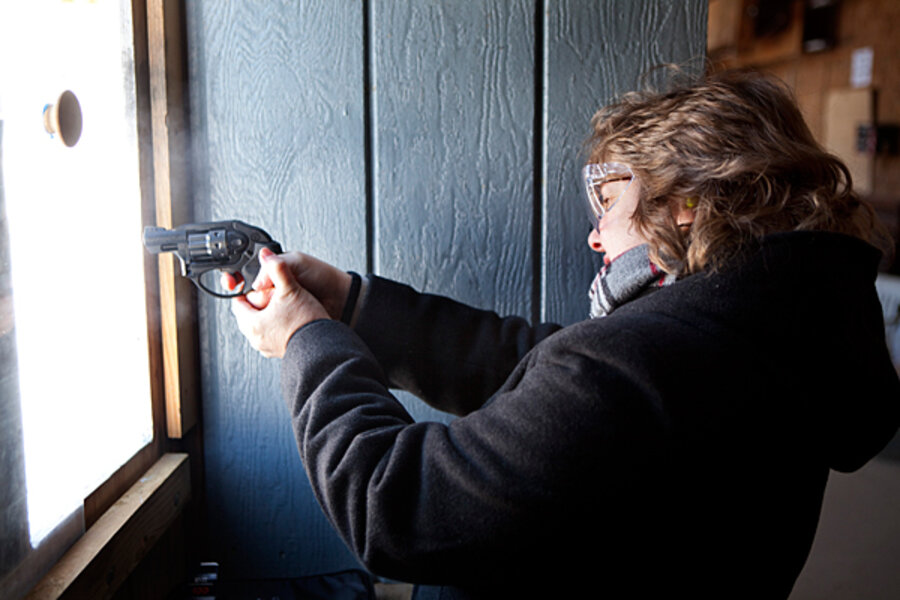Why gun ownership among US women is climbing
Loading...
Owning or carrying a gun remains mostly a guy thing, but American women who pack heat – or at least keep a pistol in the nightstand drawer – are often Exhibit A in the case for broad access to firearms for personal protection.
The opposite contention, that having a gun in the house actually makes women less safe, is the rebuttal from those who say the country needs to make guns less accessible.
As Congress, President Obama, and the nation debate the need for stricter gun laws, women’s safety is emerging as a heated and emotional issue – and one that is almost impossible to “prove” on one side or the other. Every time gun rights defenders cite an incident of a young mother defending herself and her children by shooting an intruder, gun control advocates point to a woman fatally shot in a case of domestic violence.
But it would appear that as women themselves do the calculus, a small but growing share is coming down on the side of having a gun. The gun-gravitation is not drastic: 15 percent of women in the US own guns. That, however, is up from 12 percent as recently as 2007, according to a Gallup poll released earlier this month.
Julie Warren, a consultant in Colorado Springs, Colo., keeps a handgun in her house for safety and recreation. After serving in the Air Force, she doesn’t think twice about having it.
“There is peace of mind,” she says, “knowing that you have something you can do to overpower anyone coming through the door.”
Broadly speaking, polls show women are more inclined than men to support new gun control proposals before Congress. Women support stricter gun laws in general – 62 percent compared with 40 percent of men, according to a Quinnipiac poll released Feb. 7. Sixty-eight percent of women support a nationwide ban on the sale of assault weapons, versus 44 percent of men, and 65 percent of women favor a limit on high-capacity ammunition magazines, while 46 percent of men do, the poll found. Both women and men overwhelmingly support background checks for all gun buyers, 94 percent and 90 percent, respectively.
But the argument that women need guns for personal safety and home defense resonates with many women – some of whom see government efforts to curtail gun access as a threat to their rights.
“We always hear about a woman’s right to choose, and we are women who want the right to choose how to protect our lives,” says Jenn Coffey, national director of legislative affairs for Second Amendment Sisters, a women's advocacy group with the motto “self defense is a human right.”
“Gun-control laws degrade our rights, and put more rights in the hands of criminals,” Ms. Coffey adds.
Aside from polls showing an uptick in gun ownership among women, there is other evidence that women are becoming more familiar with firearms.
The National Rifle Association, for one, is conducting more training sessions directed at women. Its Women on Target program, which started in 2000 with 500 participants, had 9,500 attendees in 2011. (The NRA does not release figures for membership.)
For another, Coffey says her local chapter of Second Amendment Sisters, in Andover, N.H., has seen a big upswing in participants at its safety trainings and target practices. The Texas-based organization, founded in 1999, now has more than 10,000 members across the US.
Women also appear to be taking greater part in gun sports. Five million women took part in target shooting in 2011, a 51.5 percent jump from 2001, according to the National Sporting Goods Association. Women who hunt increased 41.8 percent in the same period, from 1.8 million to 2.6 million, according to the association's annual sports participation reports.
But personal safety is the overriding reason women become interested in guns, at least initially, experts agree.
“Women typically own guns for safety reasons, then branch out to target shooting and hunting,” says NRA spokeswoman Stephanie Samford. “Men, on the other hand, get into guns for hunting. Safety is a secondary concern.”
Paxton Quigley, the author of women’s self-defense and gun books, says broad lifestyle changes – women waiting longer to get married, choosing to live alone, and more ofter serving as head of household – coincides with women’s rising interest in guns.
“There is a different attitude now, that women need to take responsibility for their own safety,” she says.
In the past 20 years, Ms. Quigley has taught more than 7,000 women how to use a handgun – women who aren’t necessarily ardent Second Amendment supporters, but ordinary citizens who want to protect themselves.
“I’ve taught women from all walks of life – housewives, doctors, lawyers, and teachers,” she says.
Doubts persist, however, about the degree to which a gun improves personal safety. Having a gun in the home creates more risk, including higher rates of homicide victimization, suicide attempts, and accidental shootings, studies show.
A 2006 Gallup Poll found that 49 percent of women thought having a gun in the house made it more dangerous, while 39 percent thought it made the house safer. According to a recent Monitor/TIPP poll, 46 percent of households have guns.
A gun in the home can put women at higher risk of personal injury, says David Hemenway, director of the Harvard Injury Control Research Center in Cambridge, Mass.
“There is little evidence that guns are effective when it comes to self-defense,” he says.
In his book “Private Guns, Public Health,” Dr. Hemenway argues that in high-gun states (determined by average levels of household gun ownership), the rates at which women experience gun violence are higher than in low-gun states: 3.5 times higher for gun homicides, 6 times higher for gun suicide, and 7 times higher for accidental death by gun.
Nationwide, 52 percent of homicides in which women were the victims (about 1,700 in 2010) were committed with firearms, according to the Violence Policy Center’s analysis of 2010 FBI homicide data.
“Statistics show that when females are killed, it's more likely, over 50 percent of the time, to be by a spouse or household member,” said Baltimore Police Chief Jim Johnson during a Senate hearing on gun violence Jan. 30. “A gun in a home where there is a history of domestic violence, statistics show that there is a 500 percent increase of chance that that person will be victimized by gun violence.”
Simone Smith, a marketing director in San Francisco, says she chooses not to rely on a gun for personal safety, but rather focuses on ways to reduce the likelihood of attracting criminals.
“I don’t want to have a loaded gun under my bed,” Ms. Smith says. “I wouldn’t sleep well.”
She has nothing against guns – she grew up in a family that used guns for recreation – but she says there are more effective things women can do for their personal security.
“Being aware of your neighborhood, making sure your curtains are closed, and having someone you can call will make more of a difference than having a gun,” Smith says.
Some gun-rights supporters – including women with guns – say some additional firearm controls, such as an assault-weapons ban and limits on high-capacity magazines, would help to curb gun violence.
“Handguns are more than enough for a woman to protect herself,” says Tom Cheffro, owner of Boston Firearms Training Center.
Amy Forbes, a teacher from Peabody, Mass., took Mr. Cheffro’s firearm safety training course so that she can apply for her firearm’s license and eventually buy a gun – one that would be easy for her to handle.
“You just don’t know what will happen,” Ms. Forbes says. During the hands-on training course, she learned safe handling and shooting techniques, which she says make her feel prepared for owning a weapon and defending herself.
But she supports stricter background checks for all gun sales to try to keep guns out of the hands of people with mental-health issues.
“I would support requiring a doctor’s note before being able to get a gun license, so people have to prove they are mentally stable,” says Forbes.






